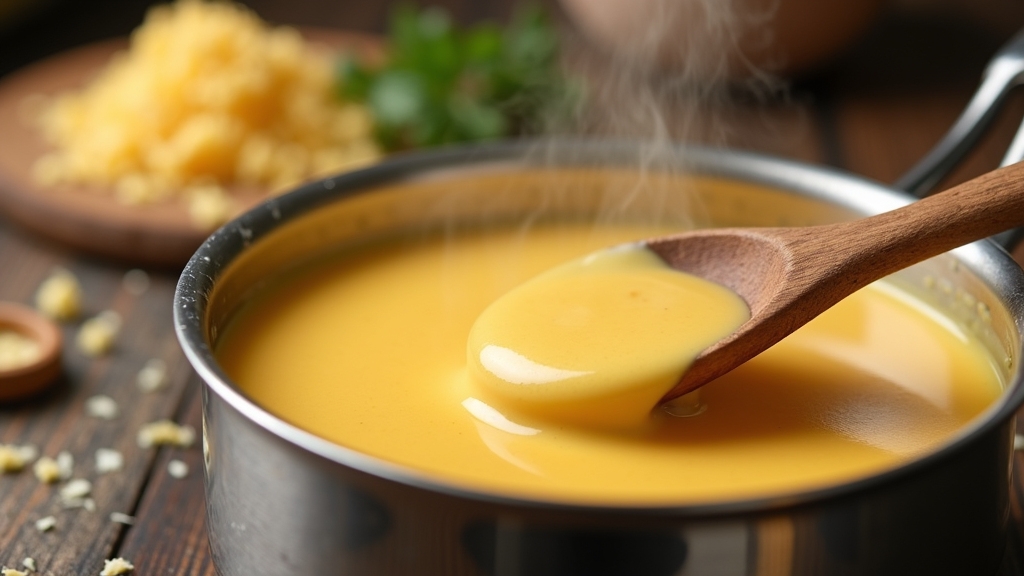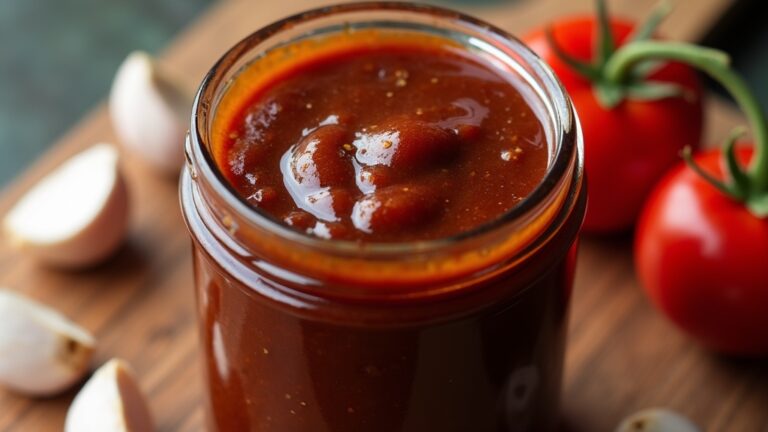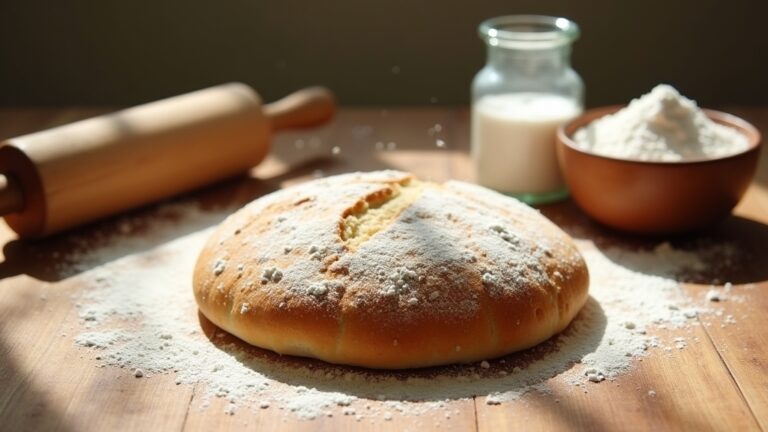Cheese Sauce Recipe
I love making cheese sauce because it’s so easy and versatile. Start by melting butter in a saucepan, then add flour to create a roux. Gradually whisk in milk until smooth, and finally, stir in your favorite cheeses for that creamy goodness. Season it with salt and pepper to taste, and you’ve got a delicious sauce ready to elevate any dish! Keep experimenting for extra flavors, and there’s so much more to explore in culinary creativity.
Contents
History
When I think about the history of cheese sauce, it’s fascinating to realize that this creamy delight has roots that stretch back centuries. The cheese origins trace back to ancient civilizations, where artisans learned to blend milk with various ingredients, creating the first forms of cheese. Over time, these basic cheeses inspired innovative sauce variations, transforming simple culinary creations into luxurious dishes. In medieval Europe, cheese sauce became a staple, often served with pasta and vegetables, showcasing its versatility. As cultures evolved, so did the flavors and techniques, leading to the diverse cheese sauces we enjoy today. From classic cheddar to spicy pepper jack, each variation tells a story of culinary creativity and tradition, inspiring us to keep experimenting in our kitchens.
Recipe
Cheese sauce is a creamy and flavorful addition that can elevate a variety of dishes, from macaroni and cheese to nachos and baked vegetables. Its rich texture and cheesy goodness make it a favorite among both kids and adults alike. Making cheese sauce at home is not only easy but also allows you to customize the flavors to suit your preference. With just a few simple ingredients, you can whip up a delicious sauce that can be used immediately or stored for later use.
Cheese sauce adds creamy, flavorful richness to dishes, making it a beloved choice for all ages.
To start, gather your ingredients and prepare your workspace. The key to a smooth cheese sauce is to guarantee that you properly melt the cheese and incorporate it with the other elements without creating lumps. Whether you are using it as a topping or a dip, this cheese sauce will add a delightful creaminess that enhances the overall taste of your dish.
Ingredients:
- 2 tablespoons butter
- 2 tablespoons all-purpose flour
- 1 cup milk
- 1 cup shredded cheese (cheddar, mozzarella, or a blend)
- 1/2 teaspoon salt
- 1/4 teaspoon black pepper
- 1/4 teaspoon garlic powder (optional)
- 1/4 teaspoon mustard powder (optional)
In a medium saucepan, melt the butter over medium heat. Once melted, whisk in the flour and cook for about 1-2 minutes until the mixture turns a light golden color. Gradually add the milk while continuously whisking to prevent lumps from forming. Continue to cook until the mixture thickens, which should take about 3-5 minutes. Once thickened, reduce the heat to low and stir in the shredded cheese until fully melted. Add salt, pepper, and any optional seasonings to taste, and mix until smooth.
For best results, use freshly grated cheese instead of pre-packaged shredded cheese, as the latter often contains anti-caking agents that can affect the texture of the sauce. If your sauce seems too thick, simply stir in a little more milk to achieve your desired consistency. Additionally, you can experiment with different cheese varieties to create unique flavors, such as adding pepper jack for a spicy kick or Parmesan for a nutty depth. Finally, keep the sauce warm over low heat before serving, and give it a good stir before using to guarantee it’s perfectly creamy.
Cooking Steps
Let’s get started on making that delicious cheese sauce! First, I melt butter in a saucepan, creating the perfect base for our creamy concoction. Then, it’s all about adding flour and gradually stirring in milk to achieve that smooth texture we crave.
Step 1. Melt Butter in Saucepan
Start by placing a medium saucepan over low to medium heat and adding a generous amount of butter. I prefer using unsalted butter for better control over the flavor, but feel free to experiment with different butter types, like garlic or herb-infused, for a unique twist.
As the butter melts, pay attention to:
- The delightful aroma filling your kitchen.
- The smooth, creamy texture forming as it begins to bubble.
- The joy of knowing you’re one step closer to a luscious cheese sauce.
Using a high-quality stainless steel or non-stick saucepan materials guarantees even melting without burning. Keep the heat gentle; you want the butter to melt gracefully, not sizzle. This foundational step sets the stage for a delicious sauce ahead!
Step 2. Add Flour to Mixture
With the butter melted and bubbling gently, it’s time to incorporate the flour into the mixture. I usually opt for all-purpose flour, but you could experiment with alternatives like whole wheat or almond flour if you’re feeling adventurous. Using about a tablespoon, I sprinkle the flour evenly over the bubbling butter, stirring quickly to combine. This is essential, as flour acts as a thickening agent, creating that desirable creamy texture we’re after. Keep stirring for about a minute to cook off the raw flavor, allowing the flour to absorb the butter’s richness. The mixture will start to thicken slightly, signaling that we’re on the right track toward a luscious cheese sauce. Now, let’s move on to the next step!
Step 3. Stir in Milk Gradually
Gradually pouring in the milk transforms our thickened flour and butter mixture into a creamy base for the cheese sauce. This step is essential for achieving the perfect milk consistency, making sure the sauce is smooth and luscious. I find that gradual incorporation helps avoid lumps, allowing the flavors to meld beautifully. Here’s how I do it:
- Start with a small amount of milk, whisking vigorously.
- Continue adding milk in small increments, ensuring each addition is fully combined before pouring in more.
- Keep an eye on the texture; you want a velvety sauce, not too thick or too runny.
Step 4. Add Cheese and Stir
Now, it’s time to elevate our creamy base by adding the cheese. I like to experiment with different cheese varieties to create a sauce that’s uniquely mine—sharp cheddar for a kick, creamy Gouda for smoothness, or even a sprinkle of blue cheese for depth. As I stir the shredded cheese into the warm mixture, I watch it melt beautifully, transforming the sauce’s texture and flavor. The key here is to find the right balance; if you want a thicker sauce, don’t be shy about adding more cheese. Each variety contributes its own character, enhancing the overall experience. I keep stirring until I achieve that velvety consistency that makes my cheese sauce irresistible. Trust me, you’ll love the innovation!
Step 5. Season With Salt and Pepper
As the cheese sauce reaches that perfect creamy texture, I can’t resist the urge to enhance its flavor with a sprinkle of salt and pepper. This simple seasoning technique can elevate your sauce from good to exceptional. Here are my favorite tips for flavor enhancement:
- Start small: Begin with a pinch of salt and a dash of pepper, tasting as you go.
- Balance it out: Adjust the seasoning to complement the cheese’s richness without overpowering it.
- Experiment: Try adding a hint of smoked paprika or garlic powder for an innovative twist.
Nutritional Guide
When whipping up a delicious cheese sauce, it’s essential to contemplate its nutritional aspects to make informed decisions about your meals. Understanding the nutritional benefits can transform your dish while exploring innovative cheese alternatives can cater to various dietary needs. Here’s a quick breakdown:
| Nutrient | Amount per Serving |
|---|---|
| Calories | 150 |
| Protein | 8g |
| Fat | 10g |
| Carbohydrates | 5g |
| Calcium | 20% DV |
Final Thoughts
Although cheese sauce is often seen as an indulgent treat, it can elevate your dishes in ways you might not expect. Its creamy richness can transform a simple meal into something extraordinary. Here are some innovative sauce variations and serving suggestions to get your creativity flowing:
- Spicy Jalapeño Cheese Sauce: Add a kick to your nachos or tacos.
- Herbed Garlic Cheese Sauce: Perfect for drizzling over steamed veggies.
- Smoky Bacon Cheese Sauce: Ideal for mac and cheese or baked potatoes.
Experimenting with these ideas not only enhances flavors but also allows you to tailor your cheese sauce to suit any occasion. So, don’t hesitate to get creative and enjoy the delicious possibilities that cheese sauce can bring to your culinary adventures!
Frequently Asked Questions
Can I Use Non-Dairy Cheese for This Sauce?
Absolutely, I’ve experimented with non-dairy options in my sauces. While the flavor differences can be noticeable, I find that with the right spices, they create a deliciously unique twist. You might love it!
How Long Does Cheese Sauce Last in the Fridge?
They say, “A stitch in time saves nine.” In the fridge, cheese sauce lasts about 3-5 days. For ideal shelf life, store it in an airtight container. Trust me, proper storage makes all the difference!
Can I Freeze Cheese Sauce for Later Use?
Absolutely, I freeze cheese sauce all the time! Just use proper freezing techniques, but be aware that texture changes might occur. Thawing slowly helps maintain its creaminess, making it perfect for later use.
What Are Good Pairings for Cheese Sauce?
Pairing cheese sauce is like finding the perfect dance partner; it elevates everything! I love it with pasta dishes, drenching fettuccine, or using it as a creamy dip for fresh veggies. It’s simply delightful!
Is Cheese Sauce Gluten-Free?
I’ve found that cheese sauce can be gluten-free, depending on the ingredients. I love using gluten-free alternatives like cornstarch or rice flour to thicken it, ensuring everyone enjoys this creamy delight without worry.
Conclusion
As I savor each creamy bite of my homemade cheese sauce, I can’t help but wonder—what’s your favorite way to enjoy this cheesy delight? Whether you pour it over nachos, drizzle it on veggies, or mix it into pasta, the possibilities are endless. Making this sauce from scratch not only elevates your dishes but also fills your kitchen with a mouthwatering aroma. So, why not give it a try and create your own cheesy masterpiece?







